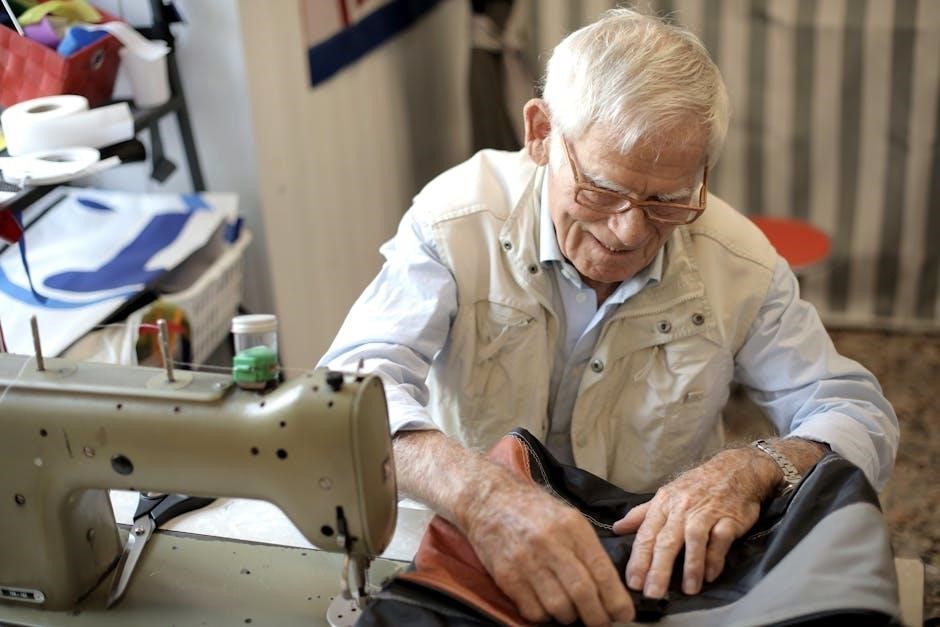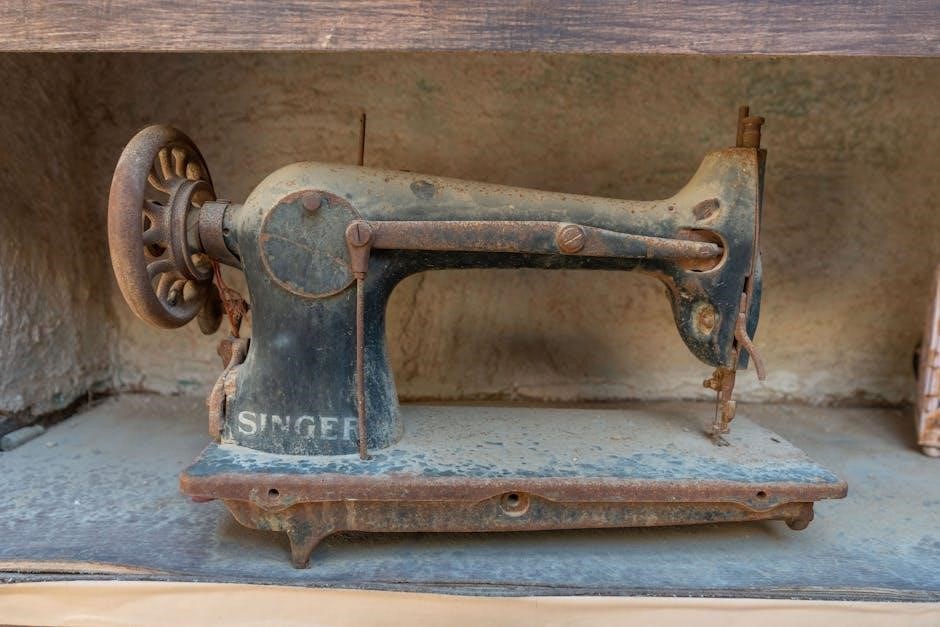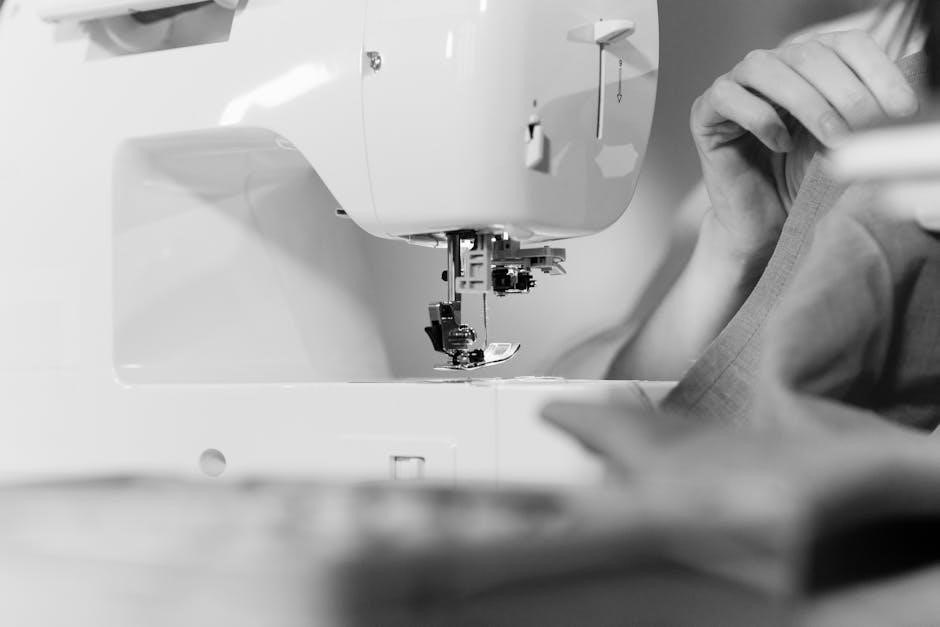Welcome to the Singer Sew Mate 5400 instruction manual; This comprehensive guide provides detailed information on operating, maintaining, and troubleshooting your sewing machine for optimal performance.
1.1 Overview of the Singer Sew Mate 5400
The Singer Sew Mate 5400 is a versatile and user-friendly sewing machine designed for both beginners and experienced sewists. With a 4.2-star rating from 41 users, it offers advanced features like multiple stitch options, automatic threading, and a free-arm design for ease of use. Suitable for various fabrics, this machine is ideal for sewing, quilting, and embroidery. It comes with essential accessories, including presser feet and a bobbin set, ensuring a smooth sewing experience. The machine’s durability and intuitive controls make it a popular choice for home and small-scale projects.
1.2 Importance of Reading the Instruction Manual
Reading the Singer Sew Mate 5400 manual is crucial for optimal performance and safety. It provides step-by-step guides for threading, bobbin winding, and selecting stitches, ensuring proper machine operation. The manual also covers troubleshooting common issues like thread breakage and uneven stitching. By following the guidelines, users can extend the machine’s lifespan and avoid costly repairs. Understanding safety precautions and maintenance tips helps prevent accidents and keeps the machine in excellent condition. Familiarizing yourself with the manual empowers you to maximize the machine’s potential and enjoy a seamless sewing experience.
1.3 Target Audience for the Manual
The Singer Sew Mate 5400 manual is designed for a broad audience, including novice sewists, experienced crafters, and professionals. Beginners benefit from clear setup and operation instructions, while advanced users appreciate detailed troubleshooting and maintenance guidance. Home sewers, hobbyists, and small business owners will find the manual’s comprehensive coverage of features and accessories invaluable. Whether you’re creating personal projects or producing custom designs, this manual ensures everyone can effectively utilize the machine’s capabilities and explore its full potential with confidence and precision.

Product Features
The Singer Sew Mate 5400 offers 540 built-in stitches, automatic needle threading, adjustable stitch length, and width, along with a free-arm design for versatile sewing projects.
2.1 Key Features of the Singer Sew Mate 5400
The Singer Sew Mate 5400 boasts an impressive array of features, including 540 built-in stitches, automatic needle threading, and an LCD display for easy stitch selection. It also includes a free-arm design, perfect for sewing cuffs and sleeves. The machine features adjustable stitch length and width, allowing for customization. With a heavy-duty metal frame, it ensures durability and stability. Additionally, it comes with 13 presser feet, enabling versatility for various sewing tasks. These features make it ideal for quilting, embroidery, and everyday sewing projects, catering to both beginners and experienced sewists.
2.2 Comparison with Other Singer Sewing Machine Models
The Singer Sew Mate 5400 stands out among Singer’s lineup with its 540 built-in stitches, surpassing models like the Heavy Duty 4423 and Stylist 7258, which offer fewer stitches. It provides more versatility and advanced features compared to these models, making it suitable for both beginners and experienced sewists. While the Quantum Stylist 9960 offers more stitches and embroidery capabilities, the 5400 balances affordability with a rich feature set, including an LCD display and 13 presser feet, ideal for a wide range of sewing projects.
2.3 Accessories Included with the Singer Sew Mate 5400
The Singer Sew Mate 5400 comes with a variety of accessories to enhance your sewing experience. These include 13 presser feet, such as the zigzag foot, zipper foot, and buttonhole foot, designed for specific tasks. You’ll also find bobbins, needles, and a seam ripper for basic sewing needs. A dust cover is provided to protect the machine when not in use. Additionally, the package includes a screwdriver and a spool pin for managing threads. These accessories ensure versatility and convenience, making it easy to tackle various sewing projects right out of the box.

Setting Up Your Sewing Machine
Unpack, inspect, and place the machine on a stable surface. Connect the power cord and presser foot. Ensure all parts are securely attached for safe operation.
3.1 Unpacking and Initial Inspection
Begin by carefully unpacking the Singer Sew Mate 5400 from its box. Inspect the machine for any visible damage or defects. Check the power cord, presser foot, and other accessories for proper condition. Ensure all components are included as listed in the manual; Gently wipe the machine with a soft cloth to remove any packaging residue. Before use, verify that all parts are securely attached and functioning correctly. This initial inspection ensures optimal performance and helps prevent future issues.
3.2 Placing the Machine on a Stable Work Surface
Position the Singer Sew Mate 5400 on a sturdy, flat surface, such as a sewing table or desk. Ensure the area is clear of clutter and moisture. Use a soft cloth or silicone mat beneath the machine to prevent slipping and protect the surface. Locate the machine near a power outlet, with the cord untangled to avoid hazards; Maintain good lighting for visibility and adjust the machine’s height for ergonomic comfort, aligning it with your seated position to prevent strain. Secure the machine firmly to ensure stability during operation.
3.3 Connecting the Power Cord and Presser Foot
To connect the Singer Sew Mate 5400, first insert the power cord into the machine’s designated port and plug it into a nearby electrical outlet. Ensure the cord is not tangled or damaged. Next, attach the presser foot by aligning it with the shank and turning the retaining ring clockwise until secure. Gently pull the presser foot to confirm it is tightly fastened. Avoid forcing it, as this may damage the machine. Once connected, test the machine by turning it on and ensuring the presser foot lifts and lowers smoothly. Always unplug the machine when not in use.

Operating the Sewing Machine
Operating the Singer Sew Mate 5400 is straightforward; Follow the guidelines for threading, selecting stitches, and adjusting settings to ensure smooth sewing experiences for all fabric types.
4.1 Threading the Machine: Step-by-Step Guide
To thread the Singer Sew Mate 5400, start by placing the spool on the spool pin and guide the thread through the machine’s tension discs. Gently pull the thread to remove any slack, then pass it through the take-up lever. Next, insert the thread into the needle’s eye, leaving a small tail. Use the built-in automatic needle threader for ease. Finally, pull the thread gently to ensure it is seated properly. Always refer to the diagram in the manual for precise alignment and tension adjustment.
4.2 Winding and Inserting the Bobbin
To wind the bobbin, place it on the bobbin winder pin and pull the end of the thread through one of the bobbin’s holes. Hold the bobbin steady and wind the thread clockwise until it is about ⅔ full. Cut the excess thread, leaving a small tail. Insert the bobbin into the bobbin case, ensuring it clicks into place. Pull the thread gently to check the tension. Finally, place the bobbin case into the machine’s bobbin area and close the compartment. Ensure the thread aligns correctly for smooth stitching.
4.3 Selecting the Right Stitch for Your Fabric
Selecting the right stitch is crucial for achieving professional results. For delicate fabrics like silk or chiffon, use the straight stitch. Heavier fabrics such as denim or canvas benefit from the heavy-duty straight stitch. Knits and stretchy materials work best with the zigzag or stretch stitch. Decorative stitches are ideal for embellishments. Use the overlock stitch for finishing seams. Always test stitches on scrap fabric to ensure proper tension and alignment. Adjust stitch length and width as needed for your project. The Singer Sew Mate 5400 offers 540 built-in stitches, ensuring versatility for any fabric type.

4.4 Basic Sewing Techniques for Beginners
Mastering basic sewing techniques is essential for beginners. Start with straight-line sewing, ensuring fabric is aligned and moving smoothly. Practice backstitching at the beginning and end of seams for security. Learn to pivot fabric at corners without breaking the stitch. Use the Singer Sew Mate 5400’s reverse stitch button to reinforce seams. Keep fabric taut but not stretched. For curves, guide fabric gently, maintaining consistent stitch length. Practice on scrap fabric to build confidence. These foundational skills will help you sew accurately and efficiently, preparing you for more complex projects.
4.5 Advanced Sewing Techniques for Experienced Users
Experienced users can explore advanced techniques like free-arm sewing for cuffs or sleeves and using the Singer Sew Mate 5400’s specialized presser feet for zippers or blind hems. Try customizing stitches by adjusting length and width for unique textures. Experiment with layered fabrics or heavy materials like denim or leather. Use the machine’s built-in decorative stitches for embellishments. For precision, utilize the sewing gauge or seam guide. Practice sewing curves smoothly and evenly. These techniques allow for intricate projects, enhancing creativity and versatility with the Singer Sew Mate 5400.

Maintenance and Care
Regularly clean the Singer Sew Mate 5400 by removing lint and debris from the bobbin area and presser foot. Oil the machine as instructed to ensure smooth operation. Always unplug the machine before cleaning or servicing. Store the machine in a dry, cool place when not in use. Proper maintenance extends the lifespan and performance of your sewing machine.
5.1 Cleaning the Machine After Use
Turn off and unplug the Singer Sew Mate 5400 before cleaning. Use a soft-bristled brush to remove lint and thread scraps from the bobbin area, presser foot, and stitch plate. Gently wipe the exterior with a dry cloth to prevent dust buildup. Avoid using liquids or harsh chemicals, as they may damage the machine. Regular cleaning ensures optimal performance and prevents fabric or thread jams. Store the machine in a protective cover when not in use to shield it from dust and moisture.
5.2 Oiling the Machine for Smooth Operation
Regular oiling is essential for the Singer Sew Mate 5400 to ensure smooth operation and extend its lifespan. Locate the oiling points, typically near the bobbin hook and shuttle race. Use a few drops of high-quality sewing machine oil, such as Singer-branded oil. Gently turn the handwheel to distribute the oil evenly. Avoid over-oiling, as excess oil can attract dust and cause residue buildup. Oil the machine after cleaning or every 10 hours of use for optimal performance. Always refer to the manual for specific oiling locations and recommendations.
5.3 Replacing Parts and Accessories
Replacing parts and accessories on the Singer Sew Mate 5400 ensures optimal performance and longevity. Always use Singer-approved replacement parts to maintain warranty validity. Identify worn or damaged components, such as needles, presser feet, or bobbin cases, and replace them promptly. Turn off and unplug the machine before starting any replacement. Follow the manual’s specific instructions for each part. For complex replacements, consult Singer’s customer support or visit an authorized service center. Regularly check and replace consumables like needles and bobbins to prevent sewing issues and ensure smooth operation.

Troubleshooting Common Issues
Identify and resolve common problems quickly with practical solutions. Address issues like machine malfunction, thread breakage, or uneven stitching with clear, step-by-step guidance for seamless troubleshooting.
6.1 Machine Not Turning On
Ensure the power cord is securely connected to both the machine and a working electrical outlet. Check for any visible damage to the cord or plug. Verify that the power switch is functioning correctly. If issues persist, test the outlet with another device. Consult a professional if the machine still does not turn on, as internal electrical components may require inspection or replacement. Always unplug the machine before performing any internal checks to avoid potential electrical hazards.
6.2 Thread Breakage or Tension Issues
Thread breakage or uneven tension can disrupt your sewing process. Check if the thread is properly threaded through the machine, ensuring it passes correctly through the tension discs and take-up lever. Verify that the presser foot is raised before threading. Adjust the tension dial to suit your fabric type. If issues persist, re-thread the machine and ensure the bobbin thread is correctly seated. Avoid using damaged or old thread, as it may cause frequent breakage. Consult the manual for recommended thread types and tension settings for optimal performance.
6.3 Bobbin Not Picking Up Thread
If the bobbin fails to pick up thread, ensure it is properly seated and aligned in the bobbin case. Check for any lint or debris in the bobbin area and clean it gently. Verify that the machine is threaded correctly and the presser foot is raised. If the issue persists, inspect the bobbin for damage or incorrect winding. Replace the bobbin if necessary and ensure it is compatible with the Singer Sew Mate 5400. After making adjustments, sew on scrap fabric to confirm the thread is picking up correctly.
6.4 Uneven Stitching or Fabric Not Moving
If the fabric isn’t moving or stitching is uneven, check the feed dogs. Ensure they are in the “up” position and functioning properly. Verify that the presser foot is lowered to maintain even fabric grip. Adjust the stitch length and width settings to suit your fabric type. Check for tangled or uneven thread tension, as this can disrupt stitch formation. Clean the feed dog area to remove lint or debris. Test on scrap fabric to ensure smooth operation. If issues persist, consult the manual or contact Singer support for assistance.

Safety Precautions
Essential tips for safe operation, avoiding potential hazards, and ensuring proper usage to prevent accidents. Regular maintenance and correct handling ensure user safety and a trouble-free experience.
7.1 General Safety Guidelines
Always wear short sleeves or tie back loose clothing to avoid entanglement. Remove jewelry that could catch on fabric or machine parts. Keep children and pets away while sewing. Use the correct needle size for your fabric type to prevent breakage. Ensure the work area is well-lit and clear of clutter. Avoid sewing when fatigued or distracted. Use the presser foot to guide fabric, keeping fingers away from the needle. Unplug the machine when not in use or during maintenance to ensure safety.
7.2 Avoiding Accidents While Sewing
Always handle sharp objects like needles and scissors with care to prevent cuts. Use a needle inserter to avoid finger pricks. Keep the sewing area clear of clutter to avoid tripping. Never sew over pins, as this can damage the machine or cause injury. Guide fabric smoothly without pulling too hard to maintain control. Regularly inspect the machine for loose parts or damaged cords. Ensure good ventilation in your sewing area to avoid inhaling dust or fumes. Following these precautions will help minimize risks and ensure a safer sewing experience.
7.3 Storing the Machine Safely
Store the Singer Sew Mate 5400 in a cool, dry place to prevent damage from moisture or heat. Clean the machine thoroughly before storage to remove dust or debris. Use a protective cover to shield it from dust. Always unplug the machine and detach the power cord to avoid electrical hazards. Store accessories separately to prevent loss or damage. Keep the machine in its original packaging or a sturdy case for added protection. Avoid placing heavy objects on the machine. Store it out of reach of children and pets to ensure safety. Regularly inspect the machine before and after storage for any signs of damage.

Warranty and Support
The Singer Sew Mate 5400 comes with a limited warranty covering parts and labor for a specified period. Singer provides dedicated customer support via phone, email, and online resources to assist with inquiries, repairs, and troubleshooting. For detailed warranty terms and support options, refer to the manual or visit Singer’s official website.
8.1 Understanding Your Warranty Coverage
The Singer Sew Mate 5400 is backed by a limited warranty that covers defects in materials and workmanship for a specified period. The warranty typically includes coverage for parts and labor under normal use. It’s essential to review the warranty terms to understand what is included and any conditions that may void the coverage. Improper use, unauthorized repairs, or failure to maintain the machine as per the manual may result in warranty termination. For detailed warranty information, refer to the manual or visit Singer’s official website.
8.2 Contacting Singer Customer Support
To contact Singer customer support, visit their official website and navigate to the “Support” section. Here, you can find contact details, including phone numbers and email addresses. Live chat options are also available for immediate assistance. For inquiries about the Singer Sew Mate 5400, ensure you have the model number ready. Additionally, the website offers a comprehensive FAQ section and downloadable resources to address common questions. Singer’s customer support team is available to assist with troubleshooting, repairs, and warranty-related queries, ensuring your sewing experience remains seamless and enjoyable.
8.3 Finding Authorized Service Centers
To locate an authorized Singer service center for your Sew Mate 5400, visit Singer’s official website. Use the “Service Center Locator” tool, which allows you to search by location or zip code. Authorized centers provide genuine parts, repairs, and maintenance, ensuring compliance with warranty terms. These centers are staffed by trained professionals who can address specific issues with your machine. Regular maintenance at authorized centers helps extend the lifespan of your Sew Mate 5400 and keeps it operating at peak performance. Always verify the center’s authorization status before scheduling a service.

The Singer Sew Mate 5400 manual provides comprehensive guidance, empowering users to maximize their sewing experience. Practice and exploration will enhance your creativity with this versatile machine.
9.1 Summary of Key Points
The Singer Sew Mate 5400 manual guides users through setup, operation, and maintenance. Key steps include unpacking, threading, bobbin insertion, and stitch selection. Maintenance tips like cleaning and oiling ensure longevity. Troubleshooting sections address common issues, while safety precautions promote accident prevention. Warranty details and support options are provided for assistance. This manual is designed to help both beginners and experienced users maximize their sewing experience with the Singer Sew Mate 5400.
9.2 Encouragement to Practice and Explore More
Now that you’ve mastered the basics of the Singer Sew Mate 5400, it’s time to explore its full potential. Practice different stitching techniques and experiment with various fabrics to enhance your sewing skills. Don’t hesitate to try advanced features and creative projects—this machine is designed to inspire your creativity. Regular use will build confidence and refine your craftsmanship. Embrace the journey of learning and enjoy the satisfaction of creating something unique with your Singer Sew Mate 5400. Happy sewing!
